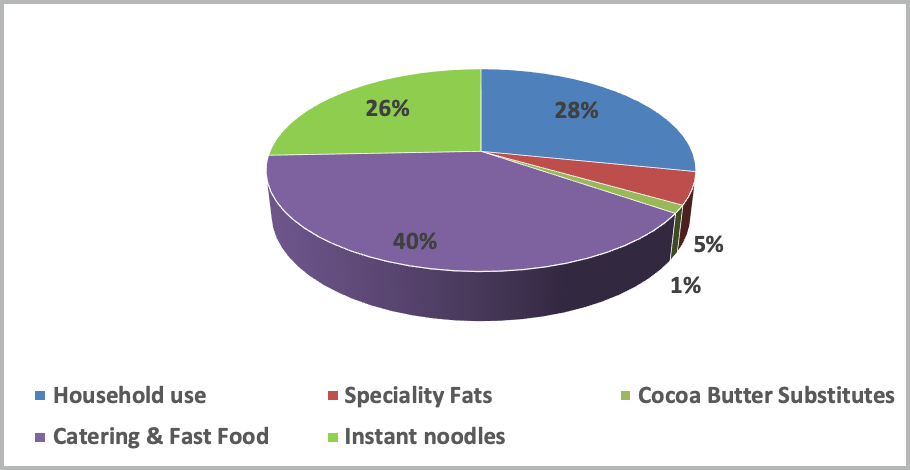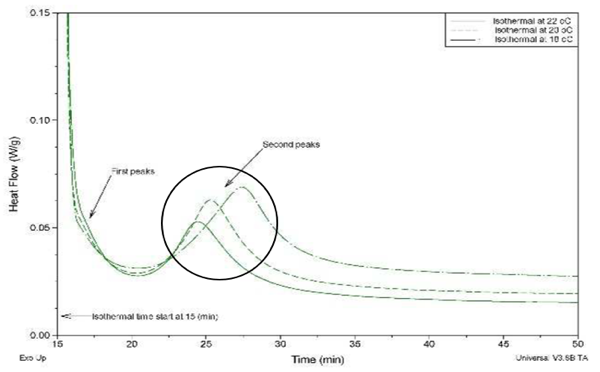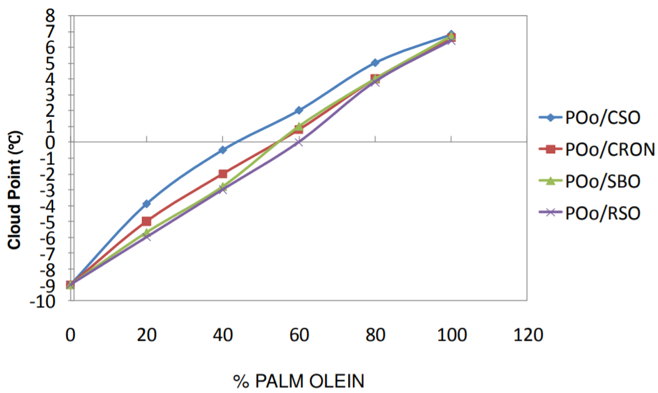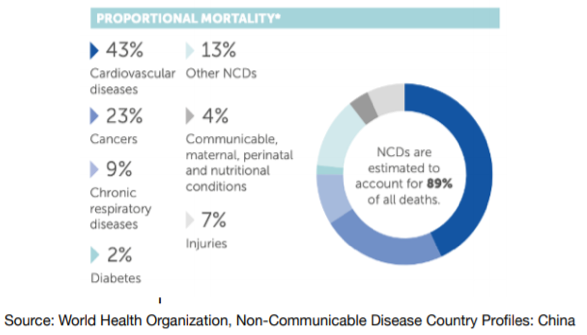1. Introduction
China‘s household market is one of the major consumers segment of palm oil in the country. In terms of volume consumed, it ranks second behind instant noodles (Refer to figure 1). Based on industrial experts feedbacks and MPOC estimates, China’s household sector accounts for 28% of the total palm oil used in the country.

Figure 1. Palm oil usage in China – breakdown by sectors
In China’s cooking oil market, the use of palm oil is not significant as there is only one pure palm oil brand available in the market. This brand is sold by Longwit. Most palm oil based cooking oils are blended with other soft oils before being marketed.
Palm oil turns cloudy in temperate climates, which is the biggest issue of marketing palm oil in China. A consumer’s understanding of the oil’s quality is influenced by cloud formation.
2. Palm Oil Crystallisation
Due to its importance in controlling product quality, crystallisation of palm oil has been extensively investigated. Crystallisation can be generally classified into two steps; nucleation and then followed by crystal growth. Palm oil starts to crystallise below 25°C due to the formation of α-crystals which appear as dotted spherulites when observed under the microscope (see Figure 2).

Figure 2. Isothermal crystallisation of RBD palm oil
In temperate countries such as China where the weather is cold, palm oil has the tendency to crystallise and turn cloudy. For example in Beijing, the minimum temperature from January to December is below 25°C (Refer to table 1). This situation will reduce the potential of selling palm oil as the oil will be crystallised the whole year.
Table 1. Beijing’s weather by month

The cloud point of palm oil when blended with other vegetable oils decreases. It has been observed that blending palm oil with other unsaturated vegetable oils results in blends that crystallise at much lower temperature than pure palm oil (Figure 3). The solution to the clouding problem is to combine palm oil with soft oil. The softening effects of palm oil are conferred by blending.

Figure 3. Cloud points of blends of vegetable oils with single fractionated palm olein
3. Benefits of Palm Oil Blends for China’s market
Currently, the top vegetable oils consumed in China are soybean oil (44%), rapeseed oil (24%), palm oil (18%), and peanut oil (9%), with other oils (cottonseed, sunflower, sesame, camellia, olive, etc.) making up the remaining 5%. The soft oils consumed are rich in polyunsaturated acids.
The problems regarding polyunsaturated-rich liquid oils such as soybean, rapeseed and sunflower oil are their odour, taste and the oil is prone to deterioration when it is use for frying at high temperature. Removing some of the double bonds through a process called partial hydrogenation can overcome this problem. But this process will form trans fatty acids which is carcinogenic.
Blending unsaturated oil with palm oil can be considered as a good alternative to partial hydrogenation. Studies reported that vegetable oils blended with palm oil showed an improvement in the finished oil quality. The blends are superior to the unmixed oils in quality.
Palm oil helps in slowing down the deterioration of soft oil.
The numerous benefits which palm oil offers to consumers can be translated into increased market receptiveness and adoption through blending. Besides being more stable, palm oil has longer shelf life and is rich in vitamin E.
4. Health Situation in China
China is the most populous country in the world, with a population of 1.4 billion people, comprising 18% of the world’s population. In 2020, it is reported that cardiovascular diseases are the leading causes of death in China (see Figure 2).

Figure 3. Proportional mortality rate in China
Dietary patterns were known as the main factors leading to the abovementioned diseases. According to the World Health Organization (WHO), a healthy diet should consist of total fat intake less than 30% of total energy intake.
Maintaining recommended dietary patterns, appropriate energy intake and adequate physical activity levels are critical to prevent unhealthy weight levels (e.g. overweight and obesity) which is one of the main cause of cardiovascular disease.
The American Heart Association’s (AHA) optimum fat blend ratio is 1: 1: 1 (saturates: monounsaturates: polyunsaturates). The optimal ratios between the aforementioned fats can be obtained by tuning the blend oil in a suitable manner. Equal proportions of palm olein and soybean oil or other liquid oil will result in a blend that are close to the recommended guidelines by AHA. In fact, overall nutrition is enhanced through palm oil’s ability to beneficially modulate LDL/HDL cholesterol ratio.
5. Conclusion
The key issue in promoting palm-based cooking oil in temperate country is that the oil turns cloudy and crystallize in temperate climate. Such visual perception always misleads the consumers into believing that the oil quality has deteriorated.
Promoting the benefits of palm-based blending is one of the way to overcome consumers concern besides educating the consumers that cloudiness and crystallization does not pose any quality problem or health risks if consumed. It has no effect on food safety, taste and quality of the oil as it is a naturally occurring phenomenon in cooler temperatures.
One of the best alternatives and solutions is to market palm olein and blended cooking oil in opaque bottles so that it will push forth more widespread acceptance to consumers. Storing cooking oil in opaque bottles will prevent consumer’s misperception as it hides the visuality of the oil cloudiness.
Prepared By Lim Teck Chaii & Nursabrina Mohd Hayat
*Disclaimer: This document has been prepared based on information from sources believed to be reliable but we do not make any representations as to its accuracy. This document is for information only and opinion expressed may be subject to change without notice and we will not accept any responsibility and shall not be held responsible for any loss or damage arising from or in respect of any use or misuse or reliance on the contents. We reserve our right to delete or edit any information on this site at any time at our absolute discretion without giving any prior notice.

